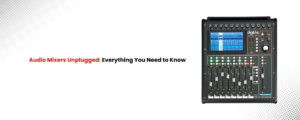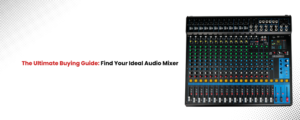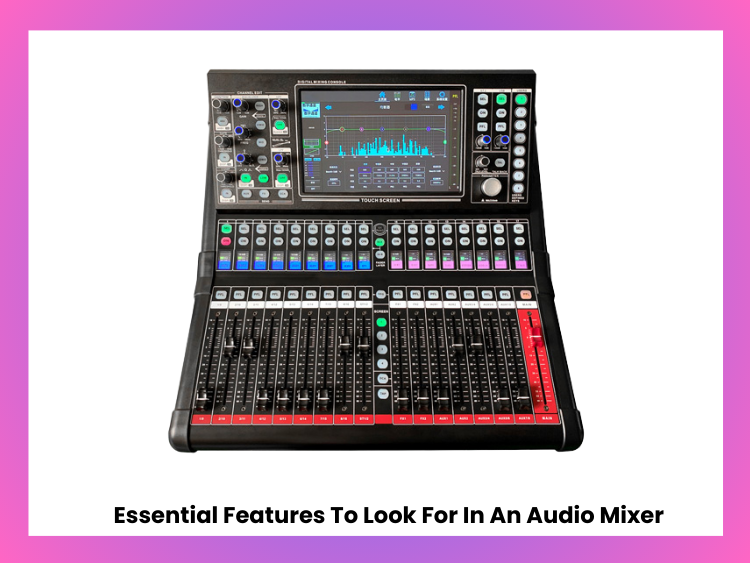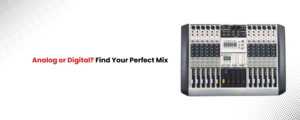Audio mixers come with many features, and it can be daunting as, with a plethora of choices, you need the right one that fits your purpose. The right features make all the difference in sound quality and usability, whether you’re setting this up for a live performance, a recording studio, or a podcast. A well-equipped mixer gives flexibility, control, and reliability in checking the same audio with the best output. In this blog, we will discuss important features to consider when buying an audio mixer.

Understanding Audio Mixers
An audio mixer — or a mixing console — is a piece of equipment that receives several audio signals, processes them, and combines them into one output. Whether performing live or in a studio, a quality mixer gives you control over volume levels, tone, effects, and more. It is important to understand the components of a mixer and how they impact sound quality to choose the right mixer.

Things To Consider When Choosing an Audio Mixer
Channels and Inputs
- The mixer channels define how many sources you will connect at once.
- For small setups, use 1-4 channels; for large setups, use 6-16 channels or above.
- In fact, for pro setups, you can require upwards of 24 channels to accommodate multiple mics, instruments, and playback devices.
Input Types:
- XLR inputs for microphones (for balanced signals, reduced interference).
- Inputs for instruments, external sources, and lines.
- USB connection for direct computer integration.
- Looking for DSD files from your USB drive.
Equalization (EQ) and Sound Processing
- Basic EQ: A three-band EQ (bass, mid, treble) to make minor sound adjustments.
- Advanced EQ: A parametric EQ is used to dial in frequencies precisely.
- Built-in Effects: Reverb, delay, and compression will add depth to your audio.
- Excellent Preamps: Minimized noise and distortion for clean sound.
- Phantom Power (+48V): Needed for condenser mics.
Gain, Faders, and Volume Control
- Gain: Controls how much input you feed to avoid distortion or too much noise.
- Faders and Volume Knobs: Let you adjust each channel manually.
- Motorized Faders (in digital mixers): Enable preset recall for efficiency.
Routing, Aux Sends & Subgroups
- Configurable Routing: The same audio signal can be routed to multiple outputs.
- Aux Sends: Set performers up with separate monitor mixes.
- Subgroups: Control many channels collectively (i.e. drums, vocals).
Direct Outputs: Used to track individual tracks separately.
Analog vs. Digital Mixers
Analog Mixers:
- Simple, fully tactile control.
- Warmer, natural sound.
- No complex digital menus.
- Ideal for novices or traditional mixers.
Digital Mixers:
- Features such as presets, built-in effects, and remote control.
- More flexibility, automation, and accuracy.
- Perfect for contemporary studios and big live events.
- Higher learning curve and higher price.
Built-in Effects and Processing
- There are onboard effects, minimizing the need for external processors.
- Use: Reverb, delay, EQ, compression, noise gating.
- Automatic Feedback Suppression: Helpful for live sound applications to prevent high-pitched noises.
Connectivity and Integration
- USB Interconnection: Allows direct recording and playback on computers.
- Multi-track Recording: This lets you record on separate tracks to edit later.
- Wireless Control: In some cases with digital mixers, this can be as simple as using an app to control your settings via Wi-Fi or Bluetooth.
Portability, Construct Quality, and Durability
- Compact Mixers: Great for solo acts and small venues.
- Heavy-Duty Mixers: Geared more toward touring musicians and live productions.
- Build Quality: Strong chassis, good knobs, and faders add to the longevity of the mixer.
Power Options and Reliability
- Some mixers have external adapters, some have integrated power supplies.
- Battery-Operated Mixers: Great for field recordings or performances in the wild.
- UPS: Backup power options to avoid any interruptions in crucial live or studio sessions.
Final Thoughts
Choosing the best audio mixer for you requires consideration of your use case, budget, and experience. For beginners, a simple analog mixer with basic EQ and effects would be a fantastic way to get started, while professionals would get more use out of a digital mixer with advanced routing, automation, and wireless control.
These key features can guide you in making a well-informed decision and investing in a mixer that improves your audio quality and workflow. From recording music to mixing live performances to producing a podcast, the right mixer will be an essential asset for outstanding sound. Pick out which ones you want, and mix them with confidence!


